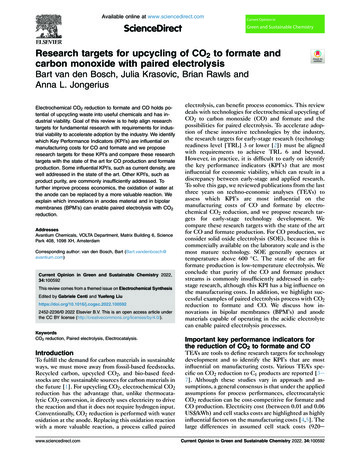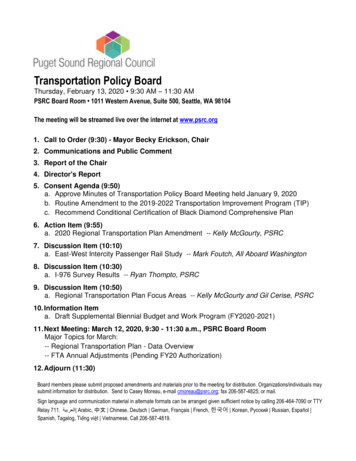
Transcription
Available online at www.sciencedirect.comScienceDirectCurrent Opinion inGreen and Sustainable ChemistryResearch targets for upcycling of CO2 to formate andcarbon monoxide with paired electrolysisBart van den Bosch, Julia Krasovic, Brian Rawls andAnna L. JongeriusElectrochemical CO2 reduction to formate and CO holds potential of upcycling waste into useful chemicals and has industrial viability. Goal of this review is to help align researchtargets for fundamental research with requirements for industrial viability to accelerate adoption by the industry. We identifywhich Key Performance Indicators (KPI’s) are influential onmanufacturing costs for CO and formate and we proposeresearch targets for these KPI’s and compare these researchtargets with the state of the art for CO production and formateproduction. Some influential KPI’s, such as current density, arewell addressed in the state of the art. Other KPI’s, such asproduct purity, are commonly insufficiently addressed. Tofurther improve process economics, the oxidation of water atthe anode can be replaced by a more valuable reaction. Weexplain which innovations in anodes material and in bipolarmembranes (BPM’s) can enable paired electrolysis with CO2reduction.AddressesAvantium Chemicals, VOLTA Department, Matrix Building 6, SciencePark 408, 1098 XH, AmsterdamCorresponding author: van den Bosch, Bart (Bart.vandenbosch@avantium.com)Current Opinion in Green and Sustainable Chemistry 2022,34:100592This review comes from a themed issue on Electrochemical SynthesisEdited by Gabriele Centi and Yuefeng -2236/ 2022 Elsevier B.V. This is an open access article underthe CC BY license ordsCO2 reduction, Paired electrolysis, Electrocatalysis.IntroductionTo fulfill the demand for carbon materials in sustainableways, we must move away from fossil-based feedstocks.Recycled carbon, upcycled CO2, and bio-based feedstocks are the sustainable sources for carbon materials inthe future [1]. For upcycling CO2, electrochemical CO2reduction has the advantage that, unlike thermocatalytic CO2 conversion, it directly uses electricity to drivethe reaction and that it does not require hydrogen input.Conventionally, CO2 reduction is performed with wateroxidation at the anode. Replacing this oxidation reactionwith a more valuable reaction, a process called pairedwww.sciencedirect.comelectrolysis, can benefit process economics. This reviewdeals with technologies for electrochemical upcycling ofCO2 to carbon monoxide (CO) and formate and thepossibilities for paired electrolysis. To accelerate adoption of these innovative technologies by the industry,the research targets for early-stage research (technologyreadiness level [TRL] 3 or lower [2]) must be alignedwith requirements to achieve TRL 6 and beyond.However, in practice, it is difficult to early on identifythe key performance indicators (KPI’s) that are mostinfluential for economic viability, which can result in adiscrepancy between early-stage and applied research.To solve this gap, we reviewed publications from the lastthree years on techno-economic analyses (TEA’s) toassess which KPI’s are most influential on themanufacturing costs of CO and formate by electrochemical CO2 reduction, and we propose research targets for early-stage technology development. Wecompare these research targets with the state of the artfor CO and formate production. For CO production, weconsider solid oxide electrolysis (SOE), because this iscommercially available on the laboratory scale and is themost mature technology. SOE generally operates attemperatures above 600 C. The state of the art forformate production is low-temperature electrolysis. Weconclude that purity of the CO and formate productstreams is commonly insufficiently addressed in earlystage research, although this KPI has a big influence onthe manufacturing costs. In addition, we highlight successful examples of paired electrolysis process with CO2reduction to formate and CO. We discuss how innovations in bipolar membranes (BPM’s) and anodematerials capable of operating in the acidic electrolytecan enable paired electrolysis processes.Important key performance indicators forthe reduction of CO2 to formate and COTEA’s are tools to define research targets for technologydevelopment and to identify the KPI’s that are mostinfluential on manufacturing costs. Various TEA’s specific on CO2 reduction to C1 products are reported [3e7]. Although these studies vary in approach and assumptions, a general consensus is that under the appliedassumptions for process performances, electrocatalyticCO2 reduction can be cost-competitive for formate andCO production. Electricity cost (between 0.01 and 0.06US /kWh) and cell stacks costs are highlighted as highlyinfluential factors on the manufacturing costs [4,5]. Thelarge differences in assumed cell stack costs (920eCurrent Opinion in Green and Sustainable Chemistry 2022, 34:100592
2 Electrochemical Synthesis15,000 US /m2 [4e6]) suggests uncertainty about therealistic costs. Current density (CD) is also commonlymentioned as highly influential. Increasing the partialCD decreases the overall cell stack costs because lesscell area is required for a specific production target.However, Sargent et al. report a nonlinear response ofthe manufacturing cost on the CD for CO production.Increasing the CD from 100 to 300 mA/cm2 results in asignificant cost reduction, further increasing the CD to1000 mA/cm2 only slightly decreases the manufacturingcosts [5]. With increasing CD, an increased cell potential translates into high electricity consumption owing toincreased overpotentials. This is an important observation, because it shows that there is an upper limit (wesuggest a value of 500 mA/cm2 for CO production) atwhich the catalytic rate can be considered satisfactory.For formate production, lower CD already results inpositive TEA [6] or shows less sensitivity in CD than forCO production [4]. The cell potential determines theenergy consumption of electrocatalytic conversions.However, variations in the cell potential between 1.6and 2.6 V seem to have a small influence on CO andformate manufacturing costs [4,5]. KPI’s that influencethe efforts for downstream processing (DSP) generallyhave a large influence on the manufacturing costs. Jiaoet al. [6] report that the CO2 conversion per passstrongly influences the manufacturing cost, especiallyfor the production of CO, and specifies a desired conversion per pass of 30%. At low conversions per pass,the CO product stream contains large amount of CO2.Removal of CO2, often by pressure swing adsorption(PSA) or membrane separation [8], is needed to achievesignificant CO purity. In the case of formate production,the CO2 stream that leaves the cell contains productsformed owing to cathodic inefficiencies (mostly H2).Removal of these products is crucial for recycling theCO2 back into the process. At low CO2 conversion perpass removal of H2 is complicated, because the H2 willbe more dilute. For DSP of formate, it is crucial toproduce concentrated product streams (w20 wt.%) [9].Formate has a high solubility even at low temperatures,and thus crystallization cannot be used for formate recovery. The energy demand for DSP methods (distillation of water for formate isolation and PSA for COpurification) as function of product purity is shown inFigure 1 to highlight the importance of product purity.For comparison, the energy demand for electrochemicalCO production is w5.5 mWh/tonne and for formateproduction w3.4 MWh/tonne (assuming low-temperature electrolysis with 90% Faraday yield (FY) andEcell 2.6 V).The stability of the electrodes and membranes requiredfor industrial viability varies from w2.3 to 5 years [4,6].However, stability measurements are time-consuming,and accelerated stability tests reduce reliability of theoutcome. A more realistic research target is set by Jiaoet al. [6], who define 100-day stability of the first targetfor an electrolyzer prototype.In Table 1 we propose research targets for the KPIs forelectrochemical production of formate and CO fromFigure 1Current Opinion in Green and Sustainable ChemistryDSP energy demands for varying product purities. Thermodynamic energy demand for water removal as function of formate concentration in productstream (left graph) and estimated energy input for PSA as function of the CO2/CO molar ratio in product. The formulas for calculating the energydemands are given in the section at the end of this review. Assumptions for PSA energy consumption: we assumed the energy consumption for state-ofthe-art technology for precombustion CO2 capture (95.7 kWh/ton CO2) [10]. Assumptions for water removal: thermodynamic energy demand for waterremoval (0.72 kWh/kg water) is built up from the energy required for heating water up from 21 to 100 C and the heat of evaporation at 100 C. PSA,pressure swing adsorption.Current Opinion in Green and Sustainable Chemistry 2022, 34:100592www.sciencedirect.com
Upcycling of CO2 with paired electrolysis van den Bosch et al.3Table 1Proposed research targets for electrochemical CO2 reduction to formate and carbon monoxide.KPIResearch targetsCO2 to formateRemarksCO2 to COCurrent density (mA/cm2)200–400300–500CO2 conversion per pass (%) 75 30Product concentration in product stream 20 wt%mole fraction 0.3Demonstrated system stability (days)100Cell potential (V)2–2.6For CO production: influential forCD 300 mA/cm2, less influential forCD 300 mA/cm2 [5]. Lower CD isassumed for formate production [6].The conversion per pass determines thepurity of the gas that leaves the cell andrequired DSP to purify this.The product purity affects the energyrequirement for DSP.For industrial viability, 2.3–5 years isdesired. For prototype demonstration, 100days is specified as target [6]CO production by SOE has lower cellpotential owing to thermal contribution tototal energy demand.CD, current density; CO, carbon monoxide; DSP, downstream processing; SOE, solid oxide electrolysis.CO2. These values are based on the assumed values thatresult in positive base cases in the highlighted TEAstudies [3e7].State of the art for CO2 reduction to carbonmonoxide and formateIn this paragraph, we review the performances in the stateof the art for electrocatalytic CO and formate productionand compare these with the research targets as we definedin Table 1. For the state of the art, we considered articlesfrom the last two years, including low-temperature electrolysis and SOE. For low-temperature electrolysis, gasdiffusion electrode (GDE) technology is the dominantmethod for promoting CO2 transport to the cathode [11].Several sophisticated catalyst designs are recently reportedfor formate production at very high CD with high FYs usingGDE technology. A single atom Pb-alloyed Cu catalystoperates at 1 A/cm2 with 92% FY [12]; a subnanostructuredBi catalyst operates at 500 mA/cm2 at 92% FY [13], and acatalyst based on InP quantum dots operates at 930 mA/cm2 at 93% FY [14]. An SneBi/SnO2 catalyst showedstable catalytic operation over 2400 h at 100 mA/cm2 at95% FY. The same catalyst in a more relevant reactorproduced a concentrated formate product stream (3.4 M,15 wt%) with 100 h stable operation [15]. When operatingat high CD, an alkaline environment is formed at thecathode. In this environment, CO2 that transportsthrough the porous layer of the GDE forms bicarbonate.Bicarbonate can accumulate, precipitate, and mechanicallydegrade and block the GDE. This ‘salting out’ is a commondegradation pathway for GDE’s [16]. When short durability measurements ( 100 h) are performed, such slowdegradation pathways can be overlooked, whereas a goodunderstanding is required to achieve industrially relevantsystem lifetimes. Performing relevant durability measurements requires investing in automated equipment,www.sciencedirect.comincluding inline analysis and safeguarding controls, inwhich an industrial process with product streams suited forDSP is mimicked on the laboratory scale. Strikingly, besides the publication of Zhong et al. [15], we did not findreports that perform long-term stability measurements athigh formate concentration. In most reports, the formateconcentration and conversion per pass are not addressed atall, although these are crucial KPIs for industrial implementation. This is in sharp contrast with the very high CDsthat are reported, which generally are higher than thesuggested research target.For the conversion of CO2 to CO, high-temperaturesolid oxide electrolysis cells ( generally operating between 600 and 850 C) are the most mature technology[17]. Stable operation under industrially relevant conditions is demonstrated for almost 8000 h [18]. In solidoxide electrolysis cells, a large portion of the total energydemand for CO2 conversion is supplied as heat, and theelectrical energy demand is reduced. Partial CD above 1A/cm2 is achieved at cell potentials of 1.5 V or lower[18,19]. For comparison, state-of-the-art low-temperature CO production with GDE technology operates at3.4 V with a stable CO partial CD around 700 mA/cm2[20]. Compared with other technologies discussed inthis review, SOE for CO production appears most likelyto be most competitive with fossil-based productiontechnologies in the near future.Paired electrolysisThe economics of electrochemical reduction processescan significantly improve when the oxidation of water atthe anode is replaced with a valuable oxidation reaction(paired electrolysis) [3]. Paired electrolysis increasesthe total production capacity of the electrolyzer andappendages and reduces energy requirement comparedCurrent Opinion in Green and Sustainable Chemistry 2022, 34:100592
4 Electrochemical Synthesiswith ‘unpaired’ redox reactions. In this paragraph, wediscuss some requirements for successfully pairingredox reactions. We only consider low-temperatureelectrolysis because paired electrolysis for the SOEwould be a completely new concept. In our opinion, tomake an industrially feasible paired electrolysis process, it is advantageous to have synergy between theanodic and cathodic reactions. Examples are CO production coupled with chlorine evolution to producefeedstocks for phosgene [21] and the reduction of CO2to formate paired with biomass oxidation to formate[6,22]. Another notable example of synergy betweenanodic and cathodic reactions is reported by Whanget al. where formate production is combined withoxidation of hydrogen to form protons. The protons andformate combine in a porous membrane betweenanodic and cathodic compartments to form a purestream of formic acid [14]. When pairing redox processes, compatibilities of pH and CD are important.The CD of both reactions must be in the same order,meaning a CD 200 mA/cm2 is needed to match CO2reduction, whereas 1000 mA/cm2 can be coupled withproton exchange membrane (PEM) hydrogen evolution. Selective oxidation reactions at such high CD arerare. In a review by Janaky et al. on CO2 reductionpaired with valuable anodic reactions, the highlightedexamples operate at lower CD than the state-of-the-artCO2 reduction processes [23] and seem limited in CDof the anodic process. To pair redox reactions, pHcompatibility of both reactions is needed for efficiention transport. When the anodic process operates at highpH, no protons are available for transport to thecathode, and other cations, such as potassium, can crossthrough a PEM. This is generally undesired, becausethis will increase the pH at the cathode and decreasethat at the anode (Figure 2). Acid and base inputs foractive pH control are very costly at industrial scale.Anion exchange membranes are a good alternative whensufficient OH is available at the cathode, but generally, this is not the case for CO2 reduction reactions,because bicarbonates will form rapidly [24]. Bipolarmembranes (BPMs) can operate at high anodic pH andcathode pH 7 while maintaining the pH stable, butthe long-term stability of BPMs at relevant catalyticconditions ( 100 mA/cm2) is not demonstrated, andthis class of membranes is less mature than PEMtechnology. However, BPMs capable of operating athigh CD are reported [25], and some benefits of BPMsin CO2 reduction processes are reported, such asreduced crossover of molecules through the membrane[5,26]. Innovating BPMs to have stable operation athigh CD ( 100 mA/cm2) can enable paired electrolysis processes with CO2 reduction reactions. Alternatively, to ensure pH compatibility, it is preferred tooperate the anodic reaction at low pH, so sufficientprotons are available for transport to the cathode.However, developing oxidation reactions in the acidicelectrolyte is challenging; generally, reactions sufferfrom lower selectivity, whereas anode materials areprone to corrode at low pH. Often noble metals (e.g.Ru, Ir) are used because of their stability, which is ahuge cost driver for cell stacks. Alternative, cheapanode materials capable of operating in acidic electrolyte are generally oxygenates of for instance post-Figure 2Ion transport in an electrochemical cell. When applying a CEM with a high pH at the anode, alkali-metal cations cross the membrane (left image). Thisresults in an increase in cathode pH and decrease in anode pH. CEM, cation exchange membrane.Current Opinion in Green and Sustainable Chemistry 2022, 34:100592www.sciencedirect.com
Upcycling of CO2 with paired electrolysis van den Bosch et al.transition metals, such as lead and tin. Such anodes arealready applied for energy storage [26] and wastewatertreatment [27]. Exploring their reactivity in electrosynthesis can be an interesting research line to enablepaired electrolysis processes.ConclusionIn summary, based on recently reported TEAs, we propose research targets for CD, CO2 conversion per pass,product purity, cell potential and demonstrated stabilityfor electrochemical CO production and formate production. We highlight the idea that product purity anddemonstrated lifetime at relevant conditions shouldmore commonly be addressed in low TRL research. Fewmature technologies are available for pairing CO2reduction with valuable oxidation reactions. Generally,synthetic oxidation reaction operates at lower CD andthereby limits the activity of the total system. In addition, oxidation reactions generally operate at high pH.This causes an incompatibility in the pH between redoxreactions; there are no protons available for transportfrom the anode to the cathode. To facilitate pairedelectrolysis with oxidation reactions operating at highpH and CO2 reduction reactions, BPMs capable ofstable operation at high CD must be developed. Ifvaluable oxidation reactions in acidic electrolyte aredeveloped, these can be paired with CO2 reduction withwell-developed PEM’s.Calculations for process energyconsumptionThermodynamic energy demand for water removal: Thethermodynamic energy demand for water removal iscalculated with the following formula: MWhMWh¼ 4:21 10 6ton COmol CO2mol CO2mol CO 35071 ton COmol CO PSA energywhere 35,071 is the number of moles CO2 that goes into 1tonne CO2.Declaration of competing interestThe authors declare that they have no known competingfinancial interests or personal relationships that couldhave appeared to influence the work reported in thisarticle.AcknowledgementsThis work was performed within the PERFORM project(grant agreement NO 820723), for which which Horizon2020 European Union funding for Research & innovation is received.ReferencesPapers of particular interest, published within the period of review,have been highlighted as:* of special interest* * of outstanding interest1.Kähler F, Carus M, Porc O, vom Berg C: Turning off the tap forfossil carbon, future prospects for a global chemical and derivedmaterial sector based on renewable carbon. 2021. http://www.renewable-carbon.eu/publications. [Accessed 27 October 2021].2.Buchner GA, Stepputat KJ, Zimmermann AW, Schomacker R:Specifying technology readiness levels for the chemical industry. Ind Eng Chem Res 2019, 58:6957–6969. https://doi.org/10.1021/acs.iecr.8b05693.3.Na J, Seo B, Kim J, Lee CW, Lee H, Hwang YJ, Min BK, Lee DK,Oh H-S, Lee U: General technoeconomic analysis for electrochemical coproduction coupling carbon dioxide reductionwith organic oxidation. Nat Commun 2019, 10:5193. https://doi.org/10.1038/s41467-019-12744-y.4.Jouny M, Luc W, Jiao F: General techno-economic analysis ofCO2 electrolysis systems. Ind Eng Chem Res 2018, 57:2165–2177. https://doi.org/10.1021/acs.iecr.7b03514.5.Kibria MG, Edwards JP, Gabardo CM, Dinh C-T, Seifitokaldani A,Sinton D, Sargent EH: Electrochemical CO2 reduction intochemical feedstocks: from mechanistic electrocatalysismodels to system design. Adv Mater 2019:1807166. https://doi.org/10.1002/adma.201807166. dTherm: energy demand ¼kgm3 ð100 wt% formateÞ kgd m3 wt% formate, 0:72 kWh5kg water6.**where d is the density which was determined experimentally. The energy for evaporation of water is 0.72 kWh/kgwater, which is the sum of the energy required to heatwater from 22 to 100 C (specific heat of water 4.186 J/kg/ C) and the energy to evaporate water at 100 C (heat ofevaporation is 40.65 kJ/mol). Conversion of J to Wh:1 J 0.000278 Wh. Energy demand for PSA energy consumption: We assumed the energy consumption of state-ofthe-art technology for precombustion CO2 capture(95.7 kWh/ton CO2). Conversion gives 4.21*10 6 MWh/mol CO2. The energy requirement is calculated with thefollowing formula:www.sciencedirect.comShin H, Hansen KU, Jiao F: Techno-economic assessment oflow-temperature carbon dioxide electrolysis. Nat Sustain2021, 4:911–919. https://doi.org/10.1038/s41893-021-00739-x.This article provides are very clear and concise TEA that clearly indicates which aspects are of highest importance for upscaling CO2reduction processes.7.Orella MJ, Brown SM, Leonard ME, Román-Leshkov Y,Brushett FR: A general technoeconomic model for evaluatingemerging electrolytic processes. Energy Technol 2019, 8:1900994. t JB, Miller DJ, Ager JW, Houle FA, Sharp ID: Thetechnical and energetic challenges of separating (Photo)Electrochemical carbon dioxide reduction products. Joule2018, 2:381–420. yor M, Dominguez-Ramos A, Perez P, Irabien A: A technoeconomic evaluation approach to the electrochemicalCurrent Opinion in Green and Sustainable Chemistry 2022, 34:100592
6 Electrochemical Synthesisreduction of CO2 for formic acid manufacture. J CO2 Util 2019,34:490–499. https://doi.org/10.1016/j.jcou.2019.07.024.10. Subravetia SG, Pai KN, Rajagopalan AK, Wilkins NS,Rajendran A, Jayaraman A, Alptekin G: Cycle design and optimization of pressure swing adsorption cycles for precombustion CO2 capture. Appl Energy 2019, .113624.11. Philips MF, Gruter G-JM, Koper MTM, Schouten KJP: Optimizingthe electrochemical reduction of CO2 to formate: a state-ofthe-art analysis. ACS Sustainable Chem Eng 2020, 8:15430–15444. https://doi.org/10.1021/acssuschemeng.0c05215.12. Zheng T, Liu C, Guo C, Zhang M, Li X, Jiang Q, Xue W, Li H, Li A,Pao C-W, Xiao J, Xia C, Zeng J: Copper-catalysed exclusiveCO2 to pure formic acid conversion via single-atom alloying.Nat Nanotechnol 2021, 16:1386–1393. https://doi.org/10.1038/s41565-021-00974-5.13. Fan L, Xia C, Zhu P, Li Y, Wang H: Electrochemical CO2* * reduction to high-concentration pure formic acid solutions inan all-solid-state reactor. Nat Commun 2020, 11:3633. https://doi.org/10.1038/s41467-020-17403-1.This articles describes the direct production of formic acid in one celland introduces an innovative concept for the isolation of pure formicacid, thereby avoiding energy intensive DSP technologies for formicacid recovery.14. Grigioni I, Sagar LK, Li YC, Lee G, Yan Y, Bertens K, Miao RK,Wang X, Abed J, Won DH, García de Arquer FP, Ip AH, Sinton D,Sargent EH: CO2 electroreduction to formate at a partial current density of 930 mA cm–2 with InP colloidal quantum dotderived catalysts. ACS Energy Lett 2021, 6:79–84. https://doi.org/10.1021/acsenergylett.0c02165.15. Li L, Ozden A, Guo S, Garcõá de Arquer FP, Wang C, Zhang M,* * Zhang J, Jiang H, Wang W, Dong H, Sinton D, Sargent EH,Zhong M: Stable, active CO2 reduction to formate via redoxmodulated stabilization of active sites. Nat Commun 2021, 12:5223. https://doi.org/10.1038/s41467-021-25573-9.This article reports production of formate from electrochemical CO2reduction with a very stable catalyst (2400 h) and this is one of the fewreports that addresses the requirement of high formate concentrations. Hereby the researcher tackle important risks for technologyupscaling and this catalytic system is thus a good candidate forupscaling.16. Schouten KJP: Taking carbon dioxide without a grain of salt.Nat Energy 2021, 6:335–336. https://doi.org/10.1038/s41560021-00823-8.Current Opinion in Green and Sustainable Chemistry 2022, 34:10059217. Hauch A, Küngas R, Blennow P, Hansen AB, Hansen JB,Mathiesen BV, Mogensen MB: Recent advances in solid oxidecell technology for electrolysis. Science 2020, 8. Küngas R: Review—electrochemical CO2 reduction for CO*production: comparison of low- and high-temperature electrolysis technologies. J Electrochem Soc 2020, 167, 044508.This article very clearly describes the state of the art SOEC technologies for CO production of CO2.19. Shi N, Xie Y, Huan D, Yang Y, Xue S, Qi Z, Pan Y, Peng R, Xia C,Lu Y: Controllable CO2 conversion in high performanceproton conducting solid oxide electrolysis cells and thepossible mechanisms. J Mater Chem 2019, 7:4855–4864.https://doi.org/10.1039/C8TA12458B.} di B, Kecsenovity E, Samu A, Halmágyi T, Rojas20. EndroCarbonell S, Wang L, Yan Y, Janákya C: Energy Environ Sci2020, 13:4098–4105. https://doi.org/10.1039/D0EE02589E.21. WO2019091653 – production and separation of phosgene bymeans of a combined CO2 and chloride electrolysis.22. WO2021152054 - electrochemical production of formate.23. Vass Á, Endrõdi B, Janáky C: Coupling electrochemical carbondioxide conversion with value-added anode processes: anemerging paradigm. Curr Opin Electrochem 2021, .003.24. Rabinowitz JA, Kanan MW: The future of low-temperaturecarbon dioxide electrolysis depends on solving one basicproblem. Nat Commun 2020, 11:5231. https://doi.org/10.1038/s41467-020-19135-8.25. Shehzad MA, Yasmin A, Ge X, Ge Z, Zhang K, Liang X, Zhang J,Li G, Xiao X, Jiang B, Wu L, Xu T: Shielded goethite catalystthat enables fast water dissociation in bipolar membranes.Nat Commun 2021, 12. https://doi.org/10.1038/s41467-02020131-1. Article number: 9.26. Zoller F, Böhm D, Bein T, Fattakhova-Rohlfing D: Tin oxidebased nanomaterials and their application as anodes inlithium-ion batteries and beyond. ChemSusChem 2019, 12:4140. https://doi.org/10.1002/cssc.201901487.27. Li J, Li M, Li D, Wen Q, Chen Z: Electrochemical pretreatmentof coal gasification wastewater with Bi-doped PbO2 electrode: preparation of anode, efficiency and mechanism.Chemosphere 2020, 248:126021. www.sciencedirect.com
Electrochemical CO2 reduction to formate and CO holds po-tential of upcycling waste into useful chemicals and has in- . For CO production, we consider solid oxide electrolysis (SOE), because this is . at 93% FY [14]. An SneBi/SnO 2 catalyst showed stable catalytic operation over 2400 h at 100 mA/cm 2 at 95% FY. The same catalyst in a more .










